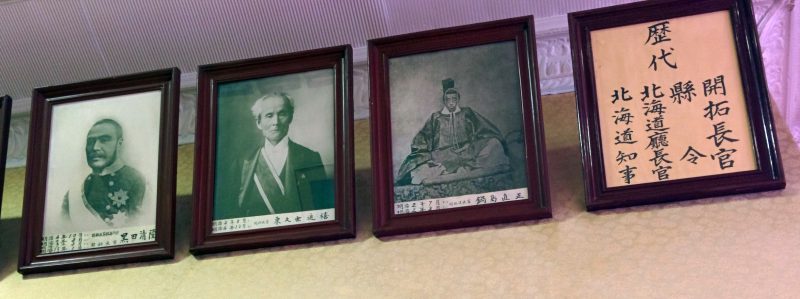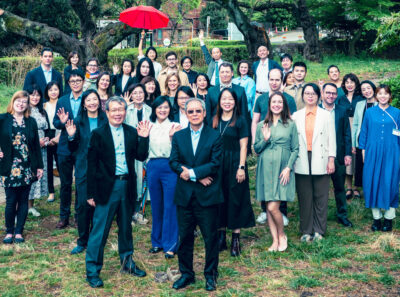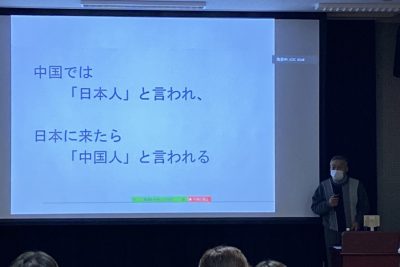The Two “Shimas”: Notes on Shima Yoshitake in Japanese Historical Memory – Part II

Shima as Explorer/Colonizer
Having surveyed the area around the city and laying out the grid pattern of its streets, Shima is today widely celebrated in both Saga and Hokkaido as Sapporo’s founder. His influence is still felt on the geography of the city, and particularly in the Chuo Ward northeast of Hokkaido Jingu Shrine. There, the site he chose for the Kaitakushi’s headquarters is occupied by both Hokkaido Prefectural Office and the Archives of Hokkaido. The surrounding neighbourhood is the city’s centre of commerce and education, with much of my own research carried out in libraries and archives in its immediate vicinity. Even as a critic of settler colonialism, then, my own career as a scholar is greatly indebted to institutions with roots in Hokkaido’s earliest colonization and, thereby, indirectly to Shima himself.
Regardless, as expressed by the plaques accompanying the two statues, he is celebrated less as a geographer or urban planner and more for having provided an intangible spiritual energy which allowed Japan to succeed in the herculean task of colonizing the northern island, with Sapporo merely acting as its springboard. In this, he is bestowed with the lofty moniker “the father of Hokkaido’s colonization (Hokkaido kaitaku no chichi 北海道開拓の父),” sharing this appellation, it should be noted, with Americans Horace Capron (chief American advisor to the Kaitakushi ) and William Smith Clark (founding president of Sapporo Agricultural College (today Hokkaido University).
It is critical here to contrast the Matsumae’s focus on profiting from the exploitation of Ainu labour/bodies and the Kaitakushi’s focus on profiting from the exploitation of Ainu land. Beginning with its annexation in 1869, Hokkaido was to be settled by Japanese mainlanders who would provide the labour required for Hokkaido’s colonization. They would transform forests into farmland, mountains into mines, and bays into ports, growing rich through the exploitation of the island’s vast natural resources. The Ainu were, in turn, overwhelmingly dispossessed of this same land and these same resources, displaced from their kotan, and largely excluded from emerging settler society. While they had lived along Hokkaido’s coasts and river valleys, they were increasingly pushed further and further inland by settlers who took over their fisheries. Even as settlers greatly benefitted from Hokkaido’s colonization, the Ainu were treated as little more than a surplus population. This led to many across Hokkaido becoming deeply impoverished, with some communities falling into a state of famine in the 1870s-1890s. Highly reminiscent of (and directly influenced by) Anglo-American settler colonialism, this process of accumulation was referred to as kaitaku (開拓), or literally the “opening up” of a new territory.
For many today, the term kaitaku evokes romantic images of hardy pioneers breaking virgin soil and building cities and industry out of the wilderness. This is the normative understanding of Hokkaido’s colonization in Japan and is reflected in Anglophone scholarship through the preferred English translation of kaitaku not as “colonization” but as “development”: phrasing that makes sense only in the absence of the Ainu. This was not the case, however, in Shima’s own time. Indeed, in the early 1870s, kaitaku was widely translated into English as “colonize” and the Kaitakushi itself alternatively the “Colonial Office” or “Colonial Department” by foreign advisors such as Capron. In this, for many Westerners, the Kaitakushi was understood as the Japanese equivalent of the British Colonial Office, which planned the colonization of, and promoted the emigration of Europeans to, territories currently occupied by the United States, Canada, and Australia. Japan’s entering into the ranks of the Euro-American colonial powers was, in this light, seen as a sign of its coming “within the pale of modern civilization,” as one American newspaper put it. And, even as it is contentious (if not polemical) today for historians to refer to Hokkaido as a “colony” in the sense of the Japanese term shokuminchi (植民地), this turn of the 20th century term quite literally refers to “planting people” into the space of the colony and accurately describes the process by which, apparently through Shima’s efforts, Ezo-chi became “Japanese.”
Arguably as part of this process, the Ainu were, as Michele Mason argues, soon after “written out” of the history of Hokkaido’s colonization, with many coming to imagine their territories as having been empty and uninhabited, or, as Nitobe Inazō (新渡戸稲造) once claimed, “untouched by human hand.” This is the view of popular narratives celebrating Shima’s role in Hokkaido’s colonization today, such as the 2014 comic book Shima Yoshitake den (島義勇伝) in which readers are encouraged to imagine the territories in the vicinity of Sapporo as having been an unpeopled “wasteland” (genya 原野) at the time of Shima’s arrival. Indeed, published for the 150th anniversary of the Meiji Restoration and officially endorsed by governments in both Saga and Hokkaido, we are meant to imagine Sapporo as having been an empty space which was filled with Shima’s “burning ‘ambition,’” becoming the modern metropolis that it is today.
While for many an enduringly romantic image, this narrative is contradicted by Shima’s own writings. In his 1858 travelogues, for example, he described in detail the Ainu he encountered throughout his journeys in Hokkaido. Indeed, in the area directly north of where he was tasked with building the Kaitakushi headquarters, and today on the grounds of Hokkaido University, stood the Ainu village Kotoni Kotan. Central to Shima’s subsequent role as a Kaitakushi magistrate, he routinely managed not just Japanese settlers but Ainu populations under his jurisdiction and at one point debated the ethics of the Kaitakushi’s Ainu policies with fellow magistrate Matsumoto Jūrō (松本十郎). The longstanding Ainu presence in Sapporo was, then, obvious to Shima and other early settlers, as were the effects of Japan’s colonization of Hokkaido on the Ainu, with Matsumoto resigning in protest. And, even while they are frequently “written out” of Hokkaido’s history, their historical presence on the land is inscribed directly into the prefecture’s maps. The overwhelmingly majority of settlements across Hokkaido -- many of them with few if any Ainu residents today -- have names of Ainu origin, including Sapporo itself (from the Ainu sat poro pet), denoting that these were previously Ainu communities.
Refuting claims that the Japanese colonization of Ainu territories was a peaceful conquest of an unpeopled land, University of Tokyo professor emeritus Komori Yōichi (小森陽一) argues that Hokkaido had been “territorialized under the colonial logic of ‘terra nullius.’” This refers to the doctrine by which the Kaitakushi officially extinguished the Ainu of sovereignty over their own territories on the basis that their territories were, indeed, empty, ownerless wasteland. These territories, Komori argues, were thereafter not peacefully settled by Japanese pioneers but “invaded,” with this invasion itself retroactively obscured by the seemingly benign term kaitaku.
And so, heroic narratives of Shima as the founding “father of the Hokkaido’s colonization” who explored Hokkaido’s unpeopled “wasteland” obscures violence inflicted upon the Ainu and erases them from the space of their own territories. This cannot but reproduce the doctrine of terra nullius into the 21st century.
Statues as History
Historically speaking, Shima was an ambiguous figure, having been at once an oppressor of the Ainu and the beheaded “traitor” of the Meiji regime. This subjective ambiguity is, however, precisely why figures such as Shima are so important in the historiography of modern Japan and why they are so fascinating for historians such as myself. And, on account of this ambiguity, many local historians in both Saga and Hokkaido challenge simplistic narratives such as those expressed in public memorials and comic books and advocate for a more nuanced approach to historical figures such as Shima as well as for greater inclusion of the Ainu and other marginalized groups into Japan’s history.
Even while Shima is directly implicated in violence not only in Hokkaido but in Saga as well, he, too, it should be noted, is largely erased through such narratives, becoming little more than a figurehead of romanticized pioneer myths. His own beliefs and experiences are ignored, as are his motivations for taking part in Hokkaido’s colonization, which, of course, stemmed not from personal “ambitions” but from his role as Nabeshima’s retainer. And, while an important figure in the national history of modern Japan, this flattening out of Shima’s life and experiences to fit the shallow mould of “great man” histories is likely due to the fact that he defies easy categorization as either a national “hero” or “villain.” Moreover, Shima’s turn against the new Meiji government is indicative of how old loyalties to by-then defunct domains still held greater sway than the nascent Japanese nation-state for many in the early Meiji period. Accordingly, a more nuanced, rigorous historical account implicitly calls into question the historicity of the supposedly timeless Japanese nation-state itself, even as the above described Shima statue at the Hokkaido Jingu seems to push it back to ancient times.
There is much to be learned from Shima, however, that is largely ignored. The history of his colonial activities in Hokkaido reveal, for example, that the origins of the Japanese colonial empire -- which at its height included virtually all of coastal East and Southeast Asia -- may be found in relative obscurity in the pastoral quietude of Saga Domain. In modern Hokkaido we see the fruition of concrete plans for imperial expansion which began in the 1830s, if not well before. This, in turn, calls into question widely-accepted myths of a isolated, inward looking feudal Japan under so-called sakoku (鎖国) laws, devoid of historical agency and subjectivity and merely waiting for Western powers to come to “open” it. According to this same logic, Japan was pulled out of feudal stagnation and pushed benevolently towards modernity by the guiding hands of Euro-American tutors. While, on this basis, generations of historians have been taught to think of the resulting Japanese imperialism as a lesser, inauthentic or even “aberrant” imitation of Euro-American colonial practices, this, too, was simply not the view of Koga, Nabeshima, or Shima. Rather, they saw Japan not as imitating but joining the Euro-American colonial powers. This is the view, too, of many critical historians today, myself included, who study the Japanese Empire’s prominent (rather than peripheral) place in world history.
Such fraught, ambiguous histories such as that which I have outlined above are rarely reflected in statues or other forms of memorialization meant for public consumption. The simple reason for this is that, such as in the case of the two “Shimas,” most statues built to valourize the “great men” of national history are not meant to teach history. They are, rather, meant to be gazed upon, admired, and perhaps even feared in their immensity, but not critically engaged with. We as spectators are, then, meant to feel a sense of awe standing before them but certainly not responsibility. On the contrary, even in the case of anti-state rebels such as Shima, we are invited to understand ourselves as part of a greater national whole and gratefully accept the spoils of the heroic deeds of the past, even if it often remains unclear what those deeds actually were. As such, many of these statues are interpolative symbols of the nation rather than a form of readable historical text. This is not, however, to say that such statues are wholly negative or worthless objects. My own interest in this history, after all, stems from an encounter with a statue in the likeness of Shima’s co-conspirator, Etō Shinpei, in Saga’s Kōno Park. Rather, it is to suggest that if we do choose to receive these symbolic objects as a form of text, we should do so on the understanding that they are man-made objects imbued with their own histories and are not, as is often suggested, “history” made manifest.
As uncomfortable as many of us are with confronting histories of violence -- especially if those who we admire are implicated -- there are rewards to doing so. Greater engagement with the past often reveals more nuanced, complex, and often more interesting histories of our own communities than what is so often presented to members of the public by image-minded politicians. Critical engagement with history is, moreover, essential for understanding our place in the complex present historical moment. And, especially for those of us (myself included) from places with unaddressed histories of violence, this is important, too, for the process of redress and reconciliation. As “history wars” are waged across the world, for all of us, I would argue, learning history rigorously and against the grain is above all critical for cultivating values of human rights and democratic citizenship to ensure a more peaceful, inclusive future.
This is a two-part blog series: Read Part I here.








